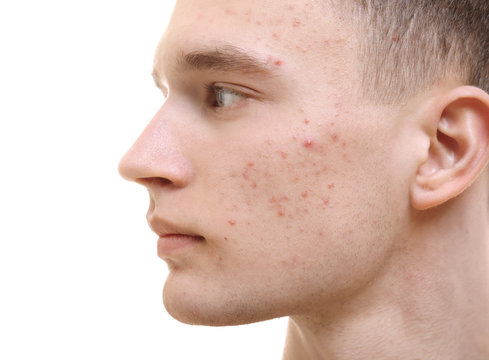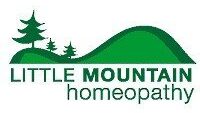Pharmaceutical acne medications such as accutane have harmful side effects. Topical acne creams can also be harmful as well as ineffective. Homeopathic treatment is effective and completely non-toxic. Homeopathy gets to the root of the problem instead of just suppressing the symptoms of acne temporarily.
Many acne sufferers can benefit from cutting out dairy from their diet, but often acne sufferers will not benefit from diet changes alone. Classical homeopathy can work effectively without requiring any change in your diet whatsoever. Homeopaths never put their clients on restrictive diets. Instead of restricting your diet, we believe in strengthening the body so that it can tolerate a wider variety of foods.
Examples of Acne Cases Helped with Homeopathy

1) Jon, a seventeen-year old youth, had been afflicted with acne since puberty. He had pustules all over his face, neck and upper back. His acne flared up from eating sweets, hot weather and sweating. During the initial visit I discovered that Jon was a mouth breather during sleep, craved sweets and spicy foods, perspired easily, was constipated, had an explosive personality and was afraid of heights. After two months and three doses of the homeopathic remedy sulphur, Jon’s skin became 50% clearer. After six months of homeopathic treatment, his skin further improved by 90%. In the process, he was no longer constipated and rarely craved sweets.
2) Monica had adult onset acne on her left thigh and buttocks, as well as on her back, chest and face. The 48-year-old school teacher had been suffering for twelve years when she first sought homeopathic treatment. Her skin was dry and scaly and felt itchy and inflamed. The acne was worse in damp weather, heat, humidity and in summer when she perspired.
Acne was not Monica’s only skin condition. She had psoriasis on the back of her neck, face, forehead, cheeks, chin and chest. In addition, due to a fungal infection, all ten of her toenails were black and slightly disfigured. Based on her unique physical symptoms, temperament, and an unusual fear of the wind, the remedy thuja was prescribed. According to Monica, her skin was 30% better within the first month. What she was more excited about was the increase in her energy level and motivation to finally join a gym. Today, after nine months of continued homeopathic treatment, Monica’s skin is totally clear from acne and psoriasis. Her fungal infection is 50% better and continuing to improve.
3) When I first met him, Stephen had been taking oral antibiotics for ten years to control his acne. He had suffered with chronic pustules, cysts and abscesses since puberty. At age forty-three, Stephen was depressed, with very little energy and motivation. Nitric acid was prescribed based on Stephen’s unique physical symptoms, character and personality. After 16 months of treatment Stephen’s face is totally clear and he no longer takes antibiotics. His spirits are much higher, and he initiated social and career changes in his life.
Homeopathy for Acne Scientific Studies
60 people were enrolled in this uncontrolled trial which was carried out in Obitsu Sankei Hospital in Kawagoe which was designed to determine the effect of individualised homeopathic medicines on several common skin disorders. These disorders included atopic dermatitis, eczema, acne, urticaria, psoriasis and alopecia universalis. Treatment occurred over a period of 3 months to 2 years and 7 months and subjects were permitted to use conventional dermatological treatments while taking part in the trial. Using the trial participants’ own assessment, improvement or otherwise was assessed using a nine-point scale similar to the Glasgow Homeopathic Hospital Outcome Scale. On this basis, 6 people reported a complete recovery, 23 reported a 75% improvement, 24 found a 50% improvement and 7 had a 25% improvement). In all, 88.3% of patients reported over 50% improvement.
Abstract
INTRODUCTION: Arctium lappa (Lappa) is used in traditional Western and Chinese medicine for acne. It is mentioned in homeopathic literature for acne, but its effect has not previously been evaluated.
OBJECTIVE: To determine the effectiveness of homeopathic medicine Lappa in treatment of acne vulgaris.
METHODS: An uncontrolled observational interventional study was conducted on human subjects who fulfilled the inclusion criteria and gave written informed consent. Lappa was prescribed in potencies starting from 6c rising to 1M as required, over a period of 6 months. Objective assessment was change in acne lesion counts supplemented with Global Acne Grading System (GAGS) and subjective assessment by using Acne-Specific Quality of Life questionnaire (Acne-QoL).
RESULTS: Out of 34 human subjects, 32 completed the follow-up. Statistical significant results were seen in lesion counts, GAGS and Acne-QoL score (p value <0.001).
CONCLUSION: Lappa has shown positive effects in the treatment of acne especially of inflammatory type. Further controlled, randomized studies with larger sample size are desirable.
Abstract
Background: Zingiber officinale (ginger) has a long history of use in traditional medicine, including homeopathy. Studies carried out so far have validated some of the ethno-medicinal observations.
Objective: To determine the effectiveness of homeopathic Z. officinale for the treatment of acne vulgaris and to identify its prescribing indications.
Methods: A prospective, non-randomised open-label study was conducted on human participants with acne vulgaris. Homeopathic Z. officinale was prescribed in different potencies (6C up to 1M) over a period of 6 months. Outcomes included changes in lesion counts, Global Acne Grading System (GAGS) score, and Acne-Specific Quality of Life (Acne-QoL) score. Data were analysed using paired t-tests, Wilcoxon signed-rank tests and Pearson’s correlation tests.
Results: Thirty-two participants enrolled in the study; data for 31 participants were analysed. Statistically significant (P<0.001) changes in lesion counts, GAGS scores and Acne-QoL scores were observed.
Conclusion: Homeopathic Z. officinale demonstrates encouraging results in the treatment of facial acne. Further investigation, using a randomised placebo-controlled trial design and a larger sample size is now required to draw firmer conclusions about the effectiveness of this intervention.
Abstract
Introduction: Azadirachta Indica (Aza.) has been used since decades in traditional medicine for the treatment of acne; even in Homoeopathy, it is recommended but its precise indications are still elusive. This study was undertaken to determine the usefulness ofAzadirachta indica in the treatment of acne vulgaris and find its indications.
Materials and Methods: A prospective, non-randomized, open-label interventional study was conducted after approval from ethical committee. Azadirachta indica was prescribed in raising potencies from 6C up to 1M. The observational period was of 6 months. Outcome measures were Lesion counts, Global Acne Grading System (GAGS) score and Acne-specific Quality of Life questionnaire (Acne-QoL) score. Data was analyzed using paired t-test, Wilcoxon signed rank tests and Pearson’s correlation tests.
Results: Out of 31 enrolled participants, 29 completed the 6-months follow-up. Two subjects did not report after 2-3 months but were included under Intention-To-Treat (ITT). Though there were overall statistically significant results in respect of Lesion counts, GAGS and Acne QoL score (P < 0.001) but no effect was seen in inflammatory lesions.
Conclusions: Azadirachta indica has a role in early and recovery phase of acne when inflammatory changes are least. Further study on a larger sample size is desirable.
